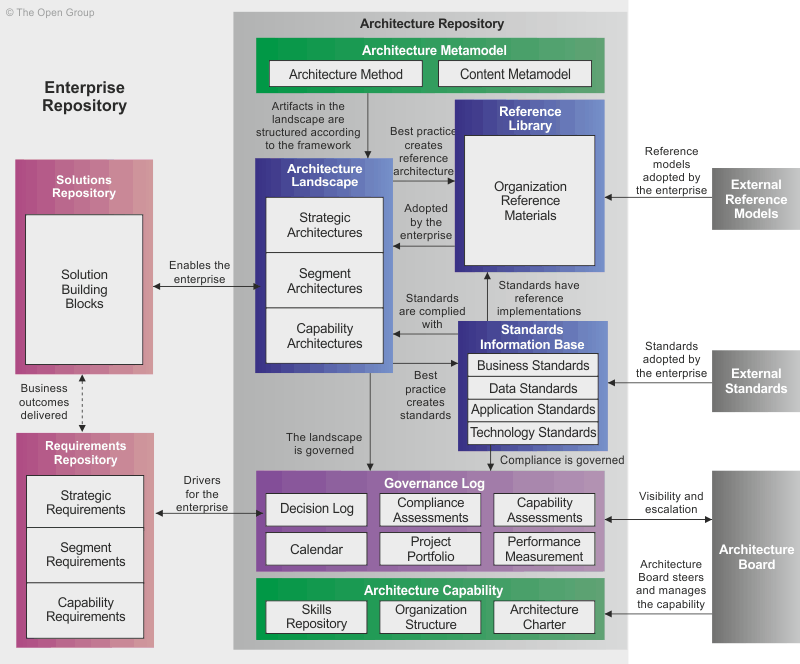Introduction
In the ever-evolving landscape of technology and business, the need for a structured and comprehensive approach to managing enterprise architecture has become increasingly evident. The Architecture Repository stands tall as a crucial component in this endeavor, serving as a centralized storehouse of knowledge, standards, and guidelines that collectively contribute to the effective governance and evolution of an enterprise’s architecture. In this article, we’ll delve into the primary components that make up the Architecture Repository, shedding light on its importance and the role it plays in shaping the technological landscape of an organization.

Components of the Architecture Repository
- Architecture Metamodel: Blueprint for Precision
At the core of the Architecture Repository lies the Architecture Metamodel. This component involves the application of an architecture framework tailored to the specific needs and nuances of a given enterprise. It serves as the blueprint, outlining the structure, relationships, and principles that guide the creation and evolution of the enterprise architecture. The Architecture Metamodel acts as a common language, ensuring that stakeholders across the organization share a unified understanding of the architectural landscape.
- Architecture Capability: Enabling Effective Governance
Architecture Capability encompasses the parameters, structures, and processes that underpin the governance of the architecture. It defines the rules, roles, and responsibilities required to ensure that the enterprise architecture aligns with business objectives and remains adaptable to changing circumstances. This component serves as the backbone of effective governance, providing the necessary tools and frameworks for decision-making and oversight.
- Architecture Landscape: Mapping the Terrain
The Architecture Landscape is a visual representation of the building blocks currently in use within the enterprise. It offers a holistic view of the architecture, detailing the relationships and interdependencies among various components. This visual map aids in identifying redundancies, optimizing resources, and making informed decisions about the evolution of the architecture. The Architecture Landscape is a dynamic snapshot that evolves as the enterprise grows and transforms.
- Standards Information Base (SIB): Upholding Consistency
Standards Information Base (SIB) is a repository of standards that architectures within the enterprise must comply with. This component ensures that technological solutions adhere to established norms, fostering interoperability and consistency. By providing a centralized repository of standards, the SIB streamlines decision-making processes and promotes a cohesive and standardized approach to architecture development.
- Reference Library: Guiding the Way
The Reference Library is a treasure trove of guidelines, templates, patterns, and reference materials that aid architects during the creation and evolution of the enterprise architecture. It serves as a knowledge hub, providing best practices, proven methodologies, and reusable artifacts that streamline the architectural process. The Reference Library not only accelerates development but also promotes consistency and quality across architectural endeavors.
- Governance Log: Tracking Progress and Decision-Making
The Governance Log is a record of governance activities across the enterprise. It tracks decisions, changes, and the rationale behind architectural choices. This log provides transparency into the governance process, enabling stakeholders to understand the evolution of the architecture and the factors influencing key decisions. The Governance Log is instrumental in fostering accountability and learning from past experiences.
Conclusion
In conclusion, the Architecture Repository stands as a linchpin in the effective management and evolution of enterprise architecture. Its components collectively provide a structured and comprehensive approach to architecture development, ensuring alignment with business objectives, adherence to standards, and adaptability to changing landscapes. As organizations continue to navigate the complexities of modern business and technology, the Architecture Repository remains an indispensable tool for those seeking to build and maintain resilient, scalable, and efficient architectural frameworks.